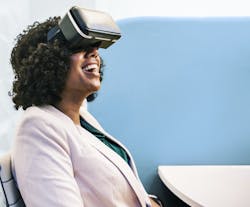Virtual reality set to become a mainstream care modality by 2021—are you ready?
Global Solutions Manager,
Lenovo Health
Virtual reality (VR) isn’t new. Before gaming and flight simulators, reality was manipulated in far more primitive ways, from panoramic paintings to stereoscopic viewers. Modern VR has arrived in healthcare and the technology is widely seen as a disruptor (the good kind) for patients and care professionals.
Preparing for augmented care delivery
In 2016 the first operation using a VR camera was performed in London and live streamed to the world allowing students, surgeons-in-training and even the public to share the experience. Recent VR adoption has steadily gained traction in new applications and capabilities and is on course to become a mainstream care modality. Today, VR platforms are found in surgical suites, doctor’s offices and in-home care.
The question isn’t whether VR goes mainstream in healthcare—the question is, “Why aren’t you using it?” We can now empower technology to serve as an augmentation of our capacity to deliver care, rather than allowing it to interfere. This is something quite revolutionary in concept.
How big will virtual care augmentation be?
According to Grand View Research,1 healthcare spending on VR/AR will surpass $1B this year and reach $5B by 2025. Analyst Cisco2 tracks even faster growth reaching $5B by 2023. All analysts see new clinical and therapeutic applications for VR as unique and valuable additions to the clinical toolbox, and all predict that this is a dose of reality worth paying attention to.
Experience tailoring equals relevancy equals efficiency
One of the most exciting aspects of VR is the flexibility it provides clinicians to deeply customize experiences helping to treat, educate and engage patients in the most personalized and impactful ways possible. Across all age groups, patient response to VR is positive and formative. Research3 shows that after two weeks, we remember 20% of what we hear, 30% of what we see, and up to 90% of what we do or simulate. VR improves a patient’s ability to understand, manage and live with their medical conditions reducing future interventions or delays in healing.
The quality of off-the-shelf VR content has also dramatically improved, and with it, the ability to transport patients away from a hospital room or doctor’s office to explore a world-famous art gallery, meet animated characters, practice new skills, enjoy on-demand concerts or visualize healthy behaviors. Tailored patient engagement makes VR infinitely more impactful, improving the care experience, increasing comprehension, and heightening self-efficacy.
Pixels and prescriptions meet
Given the broad swath of definitions surrounding digital medicine, it’s safe to say VR still has a way to go before securing its place as a full-out therapy. However, VR now enables doctors and clinicians to supplement traditional medications through alternative, non-chemical methods to avoid addictive or potentially harmful side effects.
Pain management, mental health and behavioral health are all great examples, where patients slowly learn to cope or practice awareness techniques that usually require real-world scenarios. In fact, research finds that VR’s impact lasts beyond headset removal creating greater persistence of pain relief for patients.
Keeping it real—what are the barriers to adoption?
Through field research, clinical studies, and pilot programs, the effectiveness of VR technology to improve patient satisfaction and long-term outcomes has been proven.
So, what is the final barrier that remains to be broken? Pricing? Value? Content?
It’s largely time. VR in healthcare is in its infancy but research is breaking out of the lab and moving mainstream. Industry forecasters predict that some 25% of all investment in AR/VR is in healthcare and that by 2025, the healthcare market for AR/VR will be second only to gaming.
The healthcare industry is technologically forward-thinking but compared to consumer or tech worlds, there’s a much higher regulatory burden to adopting new technology, but headway is being made, rapidly.
The most successful health organizations will adopt early and think broadly. As more augmented and mixed reality capabilities evolve, we will be able to even further diversify the use of the technology and make it a more mainstream, everyday opportunity for care delivery.
You don’t need a crystal ball to see the future—but a virtual reality headset wouldn’t hurt.
References
- Grand View Research. May 2017. Augmented Reality (AR) & Virtual Reality (VR) in Healthcare Market Analysis by Component (Hardware, Software, and Service), By Technology (Augmented Reality, Virtual Reality), And Segment Forecasts, 2018 – 2025. Retrieved from https://www.grandviewresearch.com/industry-analysis/virtual-reality-vr-in-healthcare-market
- PR Newswire. November 2017. The Augmented and Virtual Reality In Healthcare Market Was Valued at USD 769.2 Million In 2017 and Is Expected to Reach USD 4,997.9 Million By 2023, at a CAGR Of 36.6%. Retrieved from https://www.prnewswire.com/news-releases/the-augmented-and-virtual-reality-in-healthcare-market-was-valued-at-usd-7692-million-in-2017-and-is-expected-to-reach-usd-49979-million-by-2023-at-a-cagr-of-366-300560088.html
- Anderson, Heidi M. (n.d.). Dale’s Cone of Experience. Retrieved from: http://www.queensu.ca/teachingandlearning/modules/active/documents/Dales_Cone_of_Experience_summary.pdf




